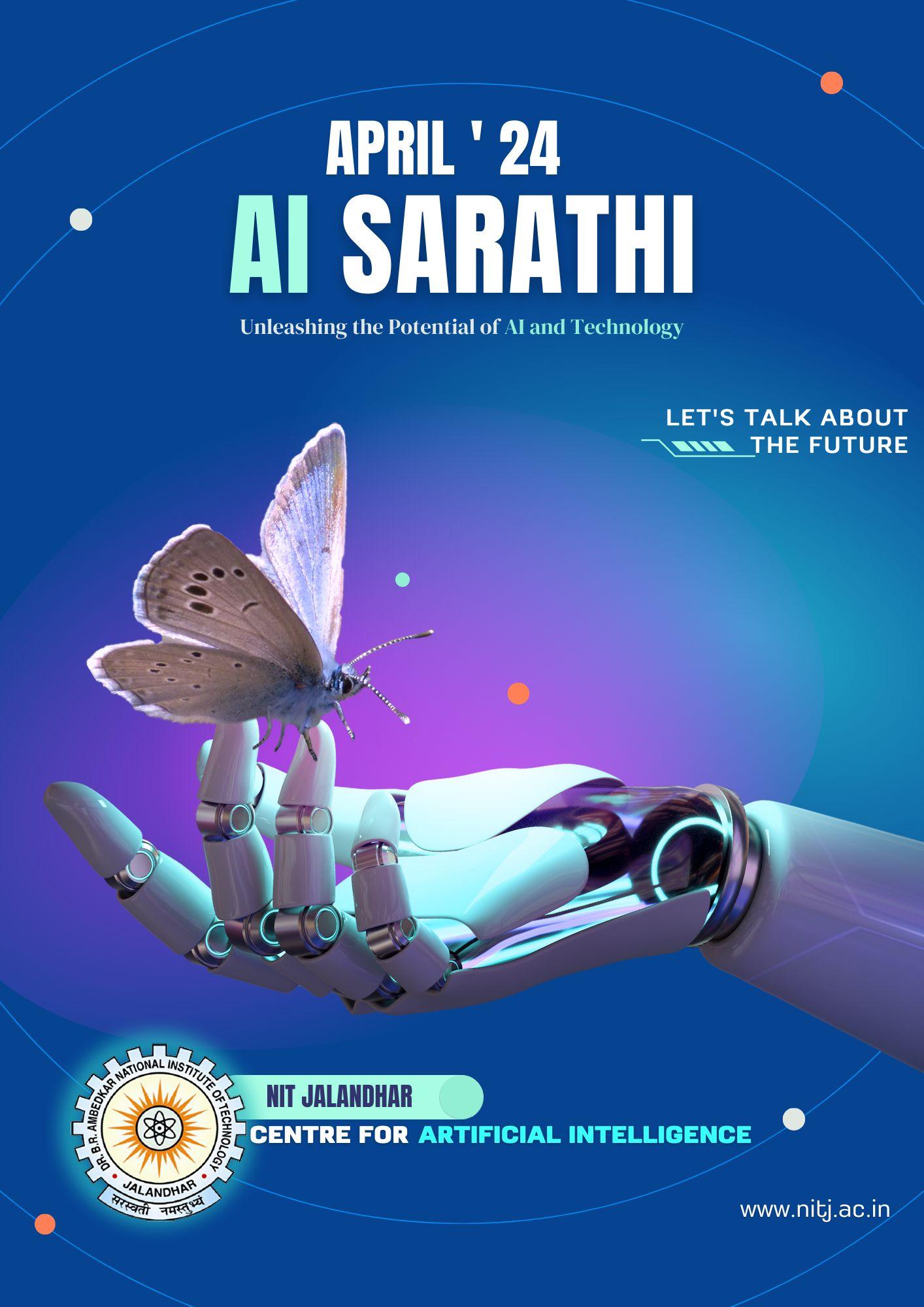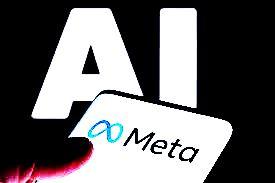





DearReaders,Itiswithgreatpleasureand enthusiasm that I extend my warmest greetings to all the readers of our Artificial Intelligence Magazine, “AI Sarathi”. As the Director of Dr B R Ambedkar National Institute of Technology Jalandhar, I take immense pride in introducing this platform that aims to be a beacon of knowledge, innovation,andcollaborationinthedynamic worldofAI.
Our institute has consistently been at the forefront of academic achievements, with our students making remarkable strides in internships,placements,andresearch.With the recent establishment of our Centre for AI,itisonlyfittingthatweembarkonanew venture to showcase our commitment to cutting-edgeresearch,responsibleAI
practices, and the worldwide collaborations within AI community. In an era defined by rapid technological transformations, the influence of AI is omnipresent, impacting industries and societies alike. Hence, this magazine goes beyond our institute's endeavors, providing a panoramic view of international developments in the AI domain.
I extend my heartfelt gratitude to the contributors, editorial team, and everyone involved in bringing this magazine to fruition. May it serve as a source of inspiration, knowledge, and a catalyst for further exploration in the dynamic field of AI.
Prof. Binod Kumar Kanaujia
Greetings Esteemed Readers, It is with immensepleasureandpridethatIextenda warmwelcometoeachofyouasweunfold the pages of AI Sarathi, a beacon of knowledge and innovation in the realm of ArtificialIntelligence.
Attheheartofouracademicecosystemlies the Centre for Artificial Intelligence, a crucible for fostering groundbreaking research, nurturing exceptional talent, and steering the course of AI-driven advancements.As the Head of this vibrant center, I find great joy in witnessing the convergence of intellect and curiosity that defines our pursuit of excellence. This magazine stands as a testament to the relentless endeavors not only of our researchers,scholars,andstudents,
but also of the broader AI community. Through its pages, you will traverse the landscapes of cutting-edge AI research, applications, and the transformative impact AIismakingacrossdiversesectors.
As we embark on this intellectual journey together, I encourage you to immerse yourselfinthenarratives,researchfindings, andvisionsthatAISarathihastooffer.May it inspire curiosity, fuel innovation, and spark new conversations in the ever-evolving landscape of Artificial Intelligence.
Thank you for being a part of this exciting venture.
DrArun K Khosla
edition of our magazine, AI Sarathi! This month's issue delves deep into the fascinating realm of artificial intelligence, exploring the age-old question: Can machines truly think like humans? We begin our journey by unraveling the mysteries of the Turing test and examining the Generative AI Paradox, contemplating the profound creations of AI that may lack understanding.
In addition to thought-provoking discussions, we bring you up-to-date with the latest AI trends and news, providing insights into recent developments shaping thefield.OurAIrepositoryoffersatreasure trove of resources to aid in your journey to mastering the fundamentals of AI and machinelearning.
SpotlightingAIinclimateaction,weexplore how AI is revolutionizing efforts to combat climate challenges, while also addressing its environmental impact, such as GPU heating. We also shine a spotlight on Atlassian and their innovative approach to AI, alongside highlighting three topAI tools forbothlearnersandindustryprofessionals. Lastly, we tackle the crucial topic of Ethical AI, shedding light on the challenges faced and the importance of ethical considerationsinAIdevelopment.
Join us as we navigate the ever-evolving landscape of AI, shaping the future with innovation, responsibility, and ethical awareness.Happyreading!
Yajat GoswamiArtificial Intelligence (AI) refers to the development of computer systems that can perform tasks typically requiring human intelligence, such as learning, problem-solving, and decision-making, by analysingdataandadaptingtonewsituations.

Machines can think like humans is a general perception in the field of artificial intelligence (AI). This inquiry encompasses various dimensions, from the definition of thinking to the practical capabilities of AI systems. While machines have made significant strides in mimicking human-like intelligence through techniques such as Machine learning and Neural networks, they still face limitations in areas like consciousness, self-awareness, and contextual understanding. The Turing Test, proposed by Alan Turing, serves as a benchmark for evaluating machine intelligence, emphasizing the ability to engage in natural language conversation indistinguishable from humans. Ethical considerations, including privacy concerns and job displacement, accompany the development of advancedAI technologies. Despite ongoing advancements and the exploration of emerging technologies like Neuromorphic computing, the fundamental question of whether machines can truly replicate human thought processes remains an openandcomplexareaofinterdisciplinarystudy.

Generative AI models can produce outputs surpassing human capabilities, yet paradoxically, they oftenlackafoundationalunderstandingoftheveryoutputstheygenerate.
Generative AI Paradox hypothesis, states that generative models learn to reproduce expert-like outputs without depending on their ability to understand them. This contrasts with humans, who usuallyneedtounderstandsomethingbeforetheycangenerateitatanexpertlevel.
For Testing this hypothesis one can conduct experiments on generative models across language and image modalities. Comparing the models’performance on generation tasks (such as writing a poem or drawing a sketch) with their performance on understanding tasks (such as answering questions or recognizing objects), measuring the correlation between generation and understanding scores, and therobustnessofthemodelstoadversarialinputs.
Generativemodelscanoutperformhumansingenerationtasks,butfallshortofhumancapabilitiesin understanding tasks. The models in above paper also show weaker correlation between generation and understanding scores, and more brittleness to adversarial inputs. These findings support the hypothesisthatmodels’generativecapabilitymaynotbecontingentuponunderstandingcapability. We can conclude that before discussing the implications of the Generative AI Paradox for the interpretation of artificial intelligence and the future of generativeAI research, seems that caution is needed when comparing artificial intelligence to human intelligence, and that more attention should bepaidtotheunderstandingaspectofgenerativemodels.
NOTE:Clickonthetitletodirectlyaccesstheresearchpaper
1. Over 70% of Indian retailers plan to adopt Gen AI over next 12 months: EY survey
A recent survey by EY in India reveals that 6% have implemented Gen AI, while 71% in retail plan to adopt it within a year, emphasizing its perceived importance. AI's expected impacts include enhancing customer experience (76%), driving product innovation (65%), and reducing costs (54%).
In a game-changing collaboration, Samsung and Google Cloud have forces to integrate Google's Generative AI technology into the upcoming Samsung Galaxy S24 series. This move signals a significant shift in the smartphone landscape, with projections indicating a surge in Gen AI-enabled devices by 2024. Samsung leads the charge by becoming the first to deploy Google's cutting-edge AI models, promising enhanced user experiences through features like advanced image rendering and natural language processing.
Mark Zuckerberg announces Meta's training of Llama 3, aiming for Artificial General Intelligence (AGI) akin to human-level intelligence, aligning with OpenAI and Google DeepMind in the pursuit. Meta emphasizes responsible open sourcing of AI technologies to democratize access while addressing ethical concerns. Llama 3, set to rival industry benchmarks like OpenAI's GPT-4, signifies Meta's commitment to advancing AI capabilities for deeper digital understanding and problem-solving.


Exploretheeducationalprowess of renowned AI expert Dr. AndrewNgthroughourfeatured AI Resources. Dive into an enlightening journey with his comprehensivemachinelearning course,delvingintokeytopics such as supervised learning (including generative/discriminative learning, neural networks, and support vector machines), unsupervisedlearning(covering clustering, dimensionality reduction,andkernelmethods), learning theory (unraveling bias/variance tradeoffs and practical advice), and reinforcement learning and adaptivecontrol.
Discover the latest applications of machine learning, ranging from robotic control tobioinformatics,asDr.Ngguidesyouthroughtheintricaciesofthisever-evolving field. Elevate your understanding of artificial intelligence with this invaluable resource,handpickedtoempoweryourlearningexperience.
AI in Climate Action emphasizes the power of artificial intelligence to address the urgent challenges posed by climate change. From optimizing renewable energy production to analyzing vast datasets for informed decision-making, AI indeed plays a pivotal role in developing innovative solutions to mitigate environmental impactandbuildasustainablefuture.

● ThetrainingofcomplexAIModels,particularlydeeplearningalgorithms,demand substantialcomputationalpower,Large-scaleAIoperationscontributetoincrease energyconsumption.
● Electronicwasteisincreasedduetorapidpaceoftechnologicaladvancementsresults inshorterlifespansofAIhardware.
● Inclimate-relateddecisions,biasedalgorithmsmaydisproportionatelyimpactcertain communitiesorneglectcriticalenvironmentalconsiderations.
● TheproductionofAIhardwarerequiresextractionofraremineralsandmetals, contributingtoenvironmentdegradation.
ItisessentialtoaddressthesechallengesusingresponsibleAIdevelopment, consideringbothshort-termbenefitsandlong-termenvironmentalaspects.
AIisinfluencingclimaterelatedeffortsbyenhancingdataanalysis, resourcemanagementanddecisionmaking.AIisemployedinoptimizing energyconsumptionindatacentreslike,
● GoogleusingDeepMindtoreducecoolingcostby40%.
● Inagriculture,AIhelpstoincreasecropyieldsthroughprecisionfarming, conservingresources.
● IBM’susemachinelearningtoenhanceweatherforecastaccuracy.
● Pacificgasandenergycompany(PG&E)usesAItopredictequipment failures,preventingpoweroutages.
● SolarandwindfarmsleverageAIforpredictivemaintenance,increasingthe reliabilityofrenewableenergysources.
● SeveralnationsclaimthatAIisquitebeneficialforimprovingclimate conditions:Source1 ,Source2,andmanymore…


Atlassian, founded in 2002 by college friends Mike Cannon-Brookes and Scott Farquhar, emerged from a simple yet profound vision.The company prioritizes authenticity, fostering an environment where individuality flourishes over conformity. Over two decades,Atlassian has grown into a global entity with a diverse workforce spanning the world, all while staying true to its foundational ethos.
At the core of Atlassian's offerings lies a commitment to empowering teams through software. One of its notable tools, Atlassian Intelligence, exemplifies this commitment.Atlassian Intelligence harnesses the power ofAI to streamline collaboration, allowing teams to accelerate their work. This innovative tool facilitates effective communication across teams within an organization,enhancingefficiency,decision-making,andoverallprocesses.
Atlassian Intelligence excels in several key areas, including transforming existing content, summarizing information, and generating new content. It assists in refining writing styles, simplifying technical information, and convertingrawnotesintovaluabledocumentation,knowledgebasearticles,and more.Teams can leverage this tool to draft new content, such as strategy pages andprojectoverviews,byprovidingclearpromptsandspecificgoals.
TheaimofAtlassianIntelligenceistoequipuserswithAI-poweredcapabilities that enhance productivity and teamwork. By providing insights into its functioning, Atlassian empowers teams to leverage this tool effectively, enablingthemtomaximizetheirpotentialandachievecollaborativesuccess.
https://www.atlassian.com/company


VREW creates speech-to-textcaptionsfor videosusingAI.Itsquick voicerecognitiontechnology eliminateslaboriousmanual transcription,andthe automaticallygenerated captionsaresimpleto modify.Additionally,it enablesyoutodecoratethe captionswithvarious borders,shadows,andfonts. Italsoallowsyoutoprovide ascriptsoitcangenerate moreaccuratecaptions. Moreover,userscancreate videoswithAIvoices,andit offersfivelanguagesand over200high-qualityAI voices.Italsoincludes practicalfeatureslikeSilence Trimmer,ManuscriptImport, andFaceEnlargementand Blur.


Clockwiseisan
AI-poweredproductivity toolthatoptimizes individualandteam schedulestocreate timeintheworkday.
ClockwiseforSlack enablesyoutoconnect withyourteamwhen you’reinameeting, outsideofworkhours, ortryingtoavoid interruptionsandfocus. Todayyoucanuse ClockwiseforSlackto automaticallysyncyour calendartoyourSlack status, turnonDoNot Disturbmodewhen you’reinameetingor inFocustime,schedule andcancelyour meetingsdirectlyfrom Slack.


Meshcapadeisa
cutting-edgeAItool developedbythe DigitalHuman Companythat combinescomputer visionandmachine learningtoconvert variousformsofdata, includingimages, videos,andtext,into realisticdigitalhuman avatars.Itspatented technologyensures highaccuracyin generatingdigital doublesandanimating fantasycharacters, makingitsuitablefora widerangeof applicationsin industrieslike e-commerce,clothing design,andgames..

As (AI) becomes increasingly important to society, experts in the field have identified a need for ethical boundaries when it comes to creatingandimplementingnewAItools.Althoughthere'scurrently no wide-scale governing body to write and enforce these rules, many technology companies have adopted their own version ofAI ethics or anAI code of conduct.AI ethics are the moral principles that companies use to guide responsible and fair development and use of AI. In this article, we'll explore what ethics in AI are, why they matter, and some challenges and benefits of developing anAI code of conduct. AI ethics are the set of guiding principles that stakeholders (from engineers to government officials) use to ensure artificialintelligencetechnologyisdevelopedandusedresponsibly. This means taking a safe, secure, humane, and environmentally friendlyapproachtoAI.
Discussion around AI ethics has progressed from being centered around academic research and non-profit organizations. Today, big tech companies like IBM, Google, and Meta have assembled teams to tackle ethical issues that arise from collecting massive amounts of data. At the same time, government and intergovernmental entities have begun to devise regulations andethicspolicybasedonacademicresearch.
Developing ethical principles for responsible AI use and development requiresindustryactorstoworktogether.
Each of these actors play an important role in ensuring less bias and risk for AItechnologies.
● Academics: Researchers and professors are responsible for developing theory-based statistics, research, and ideas that can support governments,corporations,andnon-profitorganizations.
● Government:Agencies and committees within a government can help facilitateAI ethics in a nation.Agood example of this is the Preparing fortheFutureofArtificialIntelligencereportthatwasdevelopedbythe National Science and Technology Council (NSTC) in 2016, which outlines AI and its relationship to public outreach, regulation, governance,economy,andsecurity.
● Intergovernmental entities: Entities like the United Nations and the World Bank are responsible for raising awareness and drafting agreements for AI ethics globally. For example, UNESCO’s 193 member states adopted the first ever global agreement on the Ethics of AIinNovember2021topromotehumanrightsanddignity.
There are plenty of real-life challenges that can help illustrate AI ethics. Herearejustafew.
● AIandbias
If AI doesn’t collect data that accurately represents the population, their decisions might be susceptible to bias. In 2018,Amazon was under fire for itsAIrecruitingtoolthatdowngradedresumesthatfeatured“women”(such as“Women’sInternationalBusinessSociety”)init. Inessence,theAItool discriminatedagainstwomenandcausedlegalriskforthetechgiant.
● AIandprivacy
AI relies on data pulled from internet searches, social media photos & comments, online purchases, and more. While this helps to personalize the customer experience, there are questions around the apparent lack of true consentforthesecompaniestoaccessthesepersonalinformation.
● AIandtheenvironment
SomeAImodelsarelargeandrequiresignificantamountsofenergytotrain on data. While research is being done to devise methods for energy-efficient AI, more could be done to incorporate environmental ethicalconcernsintoAI-relatedpolicies.
Dear Readers,As we conclude this inspiring edition ofAI Sarathi, we invite you to share your feedback, thoughts, and suggestions with us.Your feedback drives our commitment to delivering high-quality content that informs, inspires, and engages our readership.

Please send your feedback and letters to the editor to yajatg.ai.23@nitj.ac.in. We look forward to hearing from you!
Thank you for being a part of ourAI community. Until next time, stay curious and keep exploring the fascinating world of artificial intelligence!
Best regards,
TeamAI Sarathi